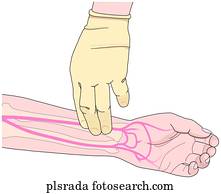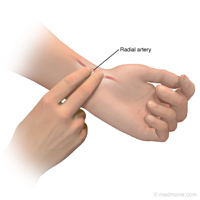
The instructor will verify the students ability to quickly locate a classmates radial pulse.

Licensed under a Creative Commons Attribution 4.0 International License, except where otherwise noted. Finger Lakes Health Outpatient Physical Therapy Services in Waterloo, 369 East Main Street, is proud to provide radial pulse therapy or shockwave therapy. Evaluation: Students will be evaluated as a Pass/Fail (P/F). Clinical Procedures for Safer Patient Care by Glynda Rees Doyle and Jodie Anita McCutcheon, British Columbia Institute of Technology. © 2015 British Columbia Institute of Technology (BCIT).Part of this content was adapted from OER #1 (as noted in brackets above): See Film clip 3.1 for use of a Doppler device. The doppler device is also used to locate the brachial pulse and assess blood pressure in infants.Īlternatively, if viewing textbook as a PDF, use this link: Chapter Attributions These devices are most commonly used when assessing peripheral pulses in the lower limbs, such as the dorsalis pedis pulse or the posterior tibial pulse. Therefore, it is helpful to know what the normal heart rate is and in an adult patient you would be expecting a range of 60-100 (Allan 2004). Based on Eastern medical theories, each pulse-measuring position corresponds to different internal organs or body parts. During diastole, or relaxation of the heart, blood volume in the arteries decreases and the. You can feel your pulse by placing your fingers over a large artery that lies close to your skin. Hence they become distended by increased blood volume during systole, or contraction of the heart. Your pulse is the vibration of blood as your heart pumps it through your arteries. Radial pulse may be absent in: situations where there has been a surgical procedure, for example in Blalock Taussig shunting, where one of the radial pulses. The Doppler device is also used following surgery or insertion of a central line to assess blood flow. When you palpate a radial pulse, you are feeling for the rate, rhythm and volume. pulse, in anatomy pulse, alternate expansion and contraction of artery walls as heart action varies blood volume within the arteries. This is a handheld device that allows you to hear the whooshing sound of the pulse. The force of the blood exiting the heart and aortic distention create a pulse wave that travels rapidly toward the extremities. Palpate the patients inner wrist on the thumb side with the fingertips of your two middle fingers.


Document whether the patients pulse is bounding or has diminished. Apply gloves with each patient before measuring the pulse. You can use a Doppler ultrasound device if you are struggling to feel the pulse and are concerned about perfusion into the limbs. Place the patient in the lateral (side-lying) position before measuring the pulse.


 0 kommentar(er)
0 kommentar(er)
